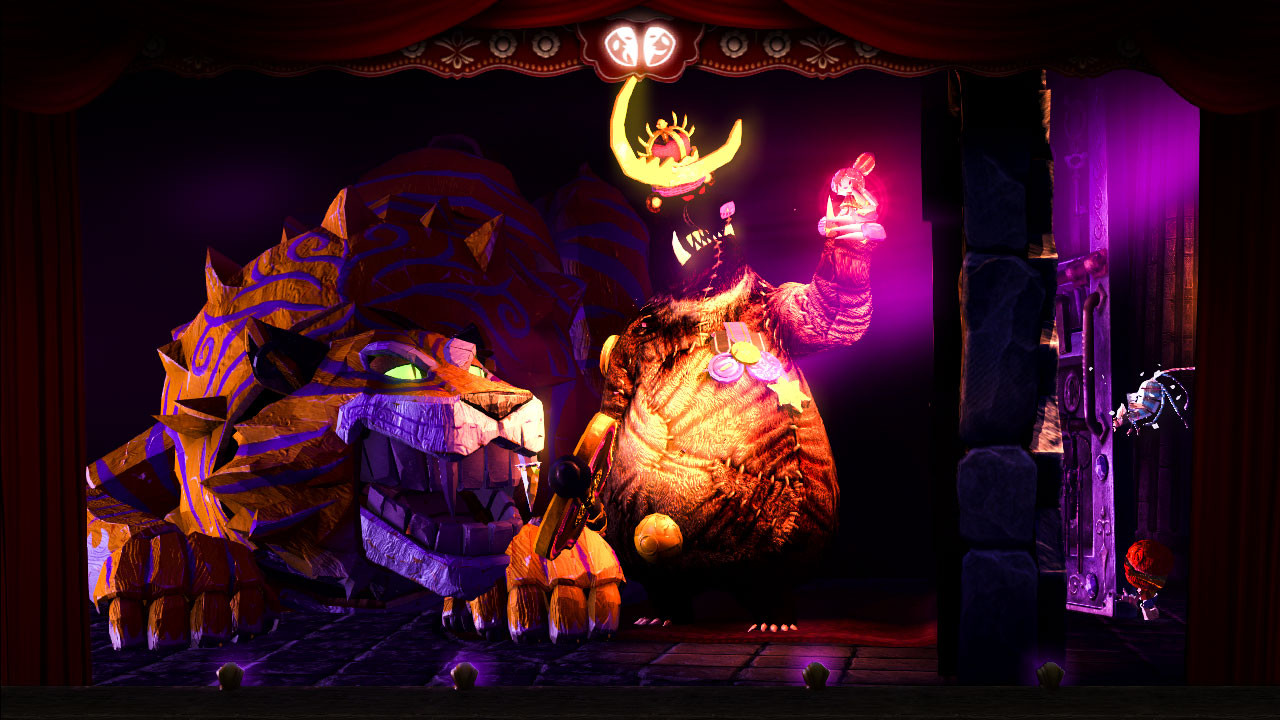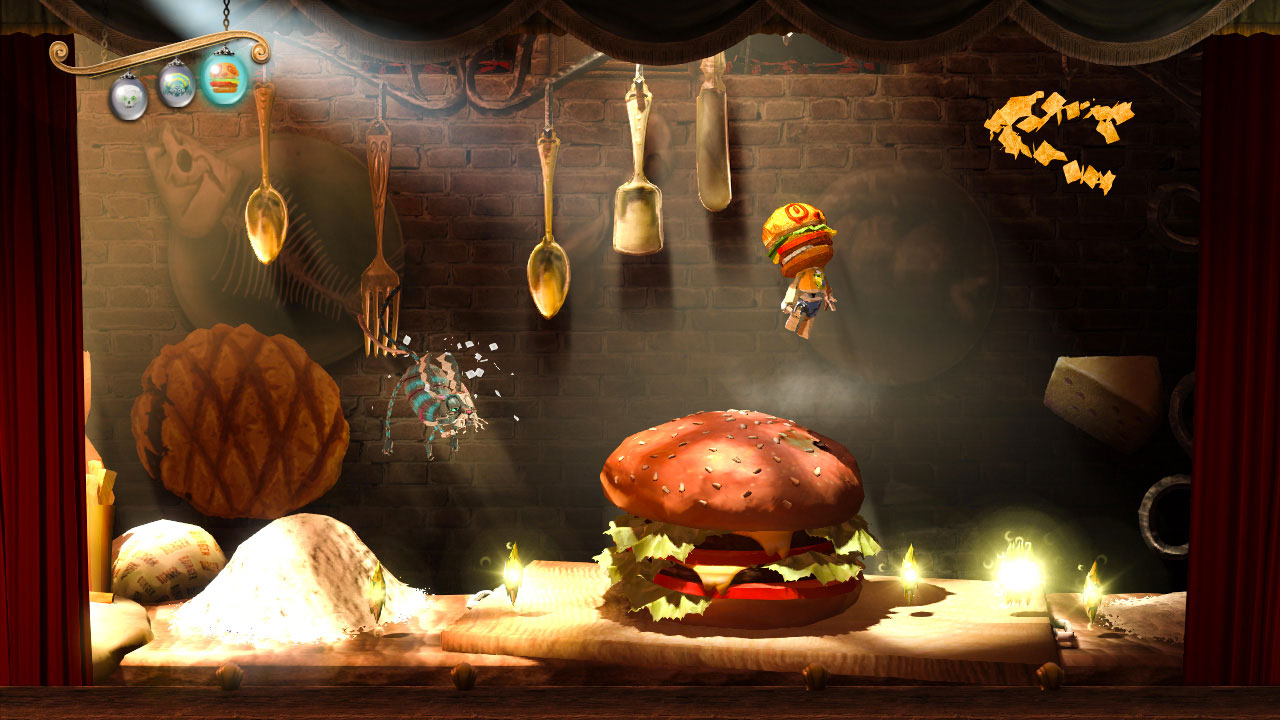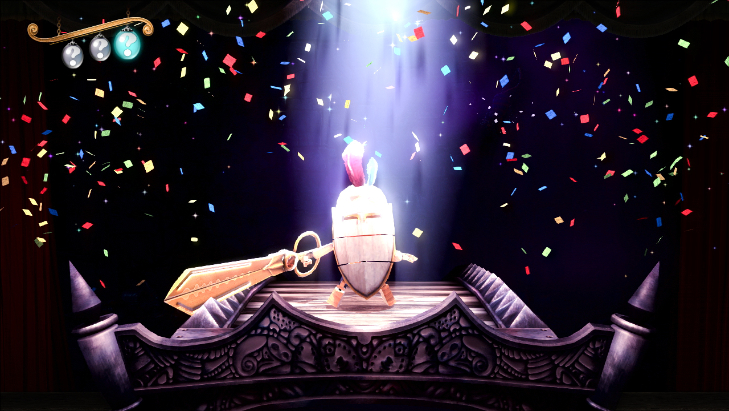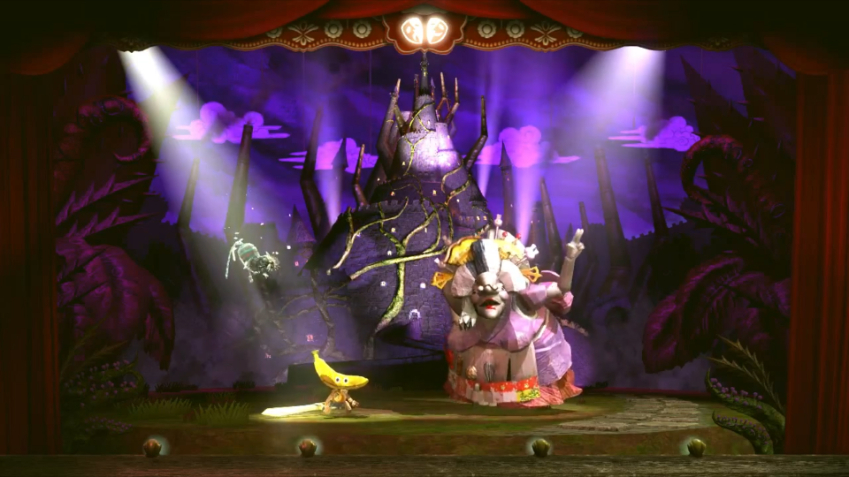It’s sometimes easy to forget about the current generation of games consoles when the next generation is on the horizon, however it is this kind of time when you start to see the last few gaming gems being released to the wide world. Hidden amongst the hype of Assassins Creed IV, Grand Theft Auto V and Beyond: Two Souls lays a rather unlikely gem by the name of: ‘Puppeteer’. From Sony Japan Studio, the creative force behind ICO, Shadow Of The Colossus and Ape Escape, this title is a wonderfully creative platform adventure that goes down as one of the best surprises this generation.
 Taking on the persona of a live theatre show, the Puppeteer is a mystical adventure that all takes place on stage with the use of puppets and mechanised sets. The story follows the adventure of a boy named Kutaro who after being turned into a puppet by the evil Moon Bear King, sets off to rid the moon of evil and restore the world back to normal. Armed with the almighty pair of scissors known as Calibrus, Kutaro jumps and slices his way throughout seven acts of theatrics with a ridiculous amount of visual and creative flair that is not often achieved so highly in videogames. The narrative here may sound like a typical fairy-tale story, but it actually transforms into something a lot bigger and grows much more entertaining fairly early on. This is certainly one fairy tale that both children and adults will enjoy immensely, packed full of humour, plot twists and fourth-wall breaking gags.
Taking on the persona of a live theatre show, the Puppeteer is a mystical adventure that all takes place on stage with the use of puppets and mechanised sets. The story follows the adventure of a boy named Kutaro who after being turned into a puppet by the evil Moon Bear King, sets off to rid the moon of evil and restore the world back to normal. Armed with the almighty pair of scissors known as Calibrus, Kutaro jumps and slices his way throughout seven acts of theatrics with a ridiculous amount of visual and creative flair that is not often achieved so highly in videogames. The narrative here may sound like a typical fairy-tale story, but it actually transforms into something a lot bigger and grows much more entertaining fairly early on. This is certainly one fairy tale that both children and adults will enjoy immensely, packed full of humour, plot twists and fourth-wall breaking gags.
This game has brilliant charm, and the developers are aware of this, consistently impressing with the art direction and theatre backdrop that makes this game feel truly magical. A spotlight constantly follows the player, a narrator will talk over the action, the audience will react to events, and musical numbers will accompany each level. Puppetter revels in its influences, and is always there to add authentic theatrics to the levels, further pushing the ‘live show’ feel it worked tirelessly to create. It’s not just the visual flair that makes this game shine so much either, the fantastic foray of characters also does its fair share to add plenty of magic. Boasting a cast of wacky characters, Puppeteer includes some fantastic voice work that helps bring the colourful and menacing characters to life. The Moon Bear King for example is a fine  example, playing up on the traditional ‘bad-guy’ character of a puppet show but with its own twist. The character does a great job of feeling evil, while also providing some great comedy scenes that feel like they have been stripped straight out of a pantomime.
example, playing up on the traditional ‘bad-guy’ character of a puppet show but with its own twist. The character does a great job of feeling evil, while also providing some great comedy scenes that feel like they have been stripped straight out of a pantomime.
While gameplay in Puppeteer may start off very basic, as the player progresses through the games seven acts they will amount a series of new gameplay mechanics that go to make the gameplay and level design that much more special. While players have the ability to run, jump and grab ledges, they can also make use of Kutaro’s companion through the use of the right analog stick. With this character the player can interact with the scenes to reap rewards or to solve puzzles, and this idea works nicely throughout and never once feels redundant. As mentioned previously, the player has access to Calibrus (by using the square button) of which can be used to attack enemies as well as being used considerably in the platforming sections, offering innovative gameplay that never ceases to be fun despite the button-mashing sometimes associated. Players are able to slice across material and travel across it, and can cut along seams to travel down a set path. The main focus of the gameplay is the use of Calibrus, but the player scenarios and levels are ever creative, and the simple mechanics never dull. The game also heavily incorporates the idea of wearing various different puppet heads to yield different effects in the games levels. Kutaro can store up to three heads at once, and can freely change between them to suit the player. These heads also act as the player health, and should Kutaro lose all three, they will die. Each act contains a plethora of different heads and a variety of different events  that can be triggered with the use of the correct head. Utilising these heads will yield player rewards such as moonstone shards (used to generate lives), new heads, or even a bonus level if you are lucky. The game encourages level exploration, adding plenty of replay value to the title as the player tries their best to find every head collectible and complete every bonus level.
that can be triggered with the use of the correct head. Utilising these heads will yield player rewards such as moonstone shards (used to generate lives), new heads, or even a bonus level if you are lucky. The game encourages level exploration, adding plenty of replay value to the title as the player tries their best to find every head collectible and complete every bonus level.
As the player progresses Kutaro will soon be able to throw bombs, use a pirates hook, a knights shield and a bulls head to name a few. These abilities are all well thought through and consistently offer themselves to the level designs, with each ability needing to be used in a variety of different ways. As you would expect, the bombs are used to blow objects and enemies up, the hook is used to pull objects, the knights shield is used to deflect enemy attacks, and the bulls head is used to slam downwards and move large objects by hand. There is a nice amount of these abilities and they never feel overwhelming and never complicate the gameplay too much. I was worried that the controls for each of these abilities would become annoyingly complex, but thankfully this isn’t the case as the controls are very simple to learn and players will soon traverse each of the seven acts with ease.
 Each act feels vastly different from the last, offering a brand new cast of characters, scenery and gameplay. While one act might see you in a Wild West style location, another might see you in a Halloween inspired setting. Each act contains three different curtains (levels) and like with the acts, feel vastly different from anything else. The creative team behind this game certainly deserves huge congratulations for being able to create such interesting levels that feel unique in their own right. While some levels are dimmed by samey boss battles, and the flow sometimes interrupted by mid-level cutscenes, all is forgiven because of the overall polished product.
Each act feels vastly different from the last, offering a brand new cast of characters, scenery and gameplay. While one act might see you in a Wild West style location, another might see you in a Halloween inspired setting. Each act contains three different curtains (levels) and like with the acts, feel vastly different from anything else. The creative team behind this game certainly deserves huge congratulations for being able to create such interesting levels that feel unique in their own right. While some levels are dimmed by samey boss battles, and the flow sometimes interrupted by mid-level cutscenes, all is forgiven because of the overall polished product.
All of these levels wouldn’t be complete without a beautiful orchestral score, of which this game delivers in droves. Featuring fantastic pieces of music to fit the action and locations before you, Puppeteer feels magical and becomes ever closer to a real piece of theatre. It is certainly one of the best game soundtracks I have heard in terms of sheer creativity, really adding to the overall theme. The games visuals are also striking, offering cartoon-like graphics that give LittleBigPlanet a run for its money. Combining vibrant colours and beautiful hand-drawn art, levels contain an outstanding amount of personality. The man-made and mechanical style of it all is also very impressive as the scenes swiftly change between each other, further adding to the constant charm of the game.
Verdict
Puppeteer is a stroke of pure genius and is a very refreshing platforming title. Its gameplay and style is so very unique that it becomes a joy to play from start to finish, offering enough challenge to be fun and enough variety to be consistently surprising. This is perhaps one of the best platformers this generation, and arguably of all time. Offering a fresh take on the tiring genre, I can’t wait to see what Sony Japan Studio put their creative minds to next!
Positives:
- Incredible amount of charm.
- Extremely fun gameplay.
- Incredible level design.
- Brilliant characters.
- Witty writing.
Negatives:
- Repeatedly mashing the square button becomes a little tiresome.
- Some boss battles feel samey.
Disclaimer:All scores given within our reviews are based on the artist’s personal opinion; this should in no way impede your decision to purchase the game.









You must be logged in to post a comment.